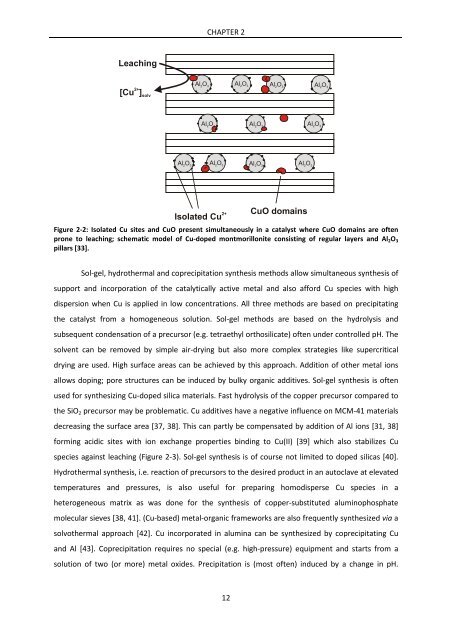Heterogeneously Catalyzed Oxidation Reactions Using ... - CHEC
Heterogeneously Catalyzed Oxidation Reactions Using ... - CHEC
Heterogeneously Catalyzed Oxidation Reactions Using ... - CHEC
You also want an ePaper? Increase the reach of your titles
YUMPU automatically turns print PDFs into web optimized ePapers that Google loves.
Leaching<br />
2+<br />
[Cu ] solv<br />
Al O<br />
2 3<br />
Al O<br />
2 3<br />
CHAPTER 2<br />
Al O<br />
2 3<br />
Al O<br />
2 3<br />
Isolated Cu 2+<br />
Figure 2‐2: Isolated Cu sites and CuO present simultaneously in a catalyst where CuO domains are often<br />
prone to leaching; schematic model of Cu‐doped montmorillonite consisting of regular layers and Al2O3<br />
pillars [33].<br />
Sol‐gel, hydrothermal and coprecipitation synthesis methods allow simultaneous synthesis of<br />
support and incorporation of the catalytically active metal and also afford Cu species with high<br />
dispersion when Cu is applied in low concentrations. All three methods are based on precipitating<br />
the catalyst from a homogeneous solution. Sol‐gel methods are based on the hydrolysis and<br />
subsequent condensation of a precursor (e.g. tetraethyl orthosilicate) often under controlled pH. The<br />
solvent can be removed by simple air‐drying but also more complex strategies like supercritical<br />
drying are used. High surface areas can be achieved by this approach. Addition of other metal ions<br />
allows doping; pore structures can be induced by bulky organic additives. Sol‐gel synthesis is often<br />
used for synthesizing Cu‐doped silica materials. Fast hydrolysis of the copper precursor compared to<br />
the SiO2 precursor may be problematic. Cu additives have a negative influence on MCM‐41 materials<br />
decreasing the surface area [37, 38]. This can partly be compensated by addition of Al ions [31, 38]<br />
forming acidic sites with ion exchange properties binding to Cu(II) [39] which also stabilizes Cu<br />
species against leaching (Figure 2‐3). Sol‐gel synthesis is of course not limited to doped silicas [40].<br />
Hydrothermal synthesis, i.e. reaction of precursors to the desired product in an autoclave at elevated<br />
temperatures and pressures, is also useful for preparing homodisperse Cu species in a<br />
heterogeneous matrix as was done for the synthesis of copper‐substituted aluminophosphate<br />
molecular sieves [38, 41]. (Cu‐based) metal‐organic frameworks are also frequently synthesized via a<br />
solvothermal approach [42]. Cu incorporated in alumina can be synthesized by coprecipitating Cu<br />
and Al [43]. Coprecipitation requires no special (e.g. high‐pressure) equipment and starts from a<br />
solution of two (or more) metal oxides. Precipitation is (most often) induced by a change in pH.<br />
12<br />
Al2O3 Al O<br />
Al O<br />
Al O<br />
2 3<br />
Al O<br />
2 3<br />
2 3<br />
Al O<br />
2 3<br />
CuO domains<br />
Al O<br />
2 3<br />
2 3



